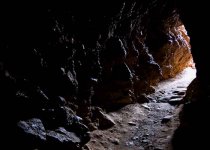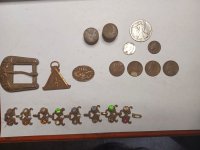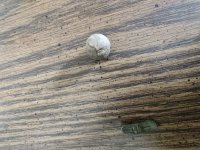Crow
Silver Member
- Jan 28, 2005
- 3,332
- 9,314
- Detector(s) used
- ONES THAT GO BEEP! :-)
- Primary Interest:
- Other
Gidday Amigos
The Chinkanas as it is known in the local language, aren't one cave but rather a series of underground passages and galleries. The name of these Incan caves comes from the Quechua word chinkana, which means "place where one is lost." They're located in Cusco, close to the Sacsayhuaman historical site. Nobody's sure whether these underground labyrinths were made by the Incas or a civilization that came before them.

The smallest of the chinkanas, called chinkana chica, is accessible to the public and is located just shy of a mile (150 meters) from the taxiway in Cusco. However, many areas are closed to the public as people could get lost inside.

Around these mysterious constructions, we say ?constructions? because it is notorious that they were made by the hand of man in some remote past, although part of it could be natural tunnels of geology, many conjectures, myths and legends have been woven: some claim that they were made by an unknown antediluvian civilization, and others say that it was the Incas who made these labyrinths to enter the bowels of the Pachamama (Mother Earth) and perform sacred rituals within it.

Different chroniclers have left data on the Inca chinkanas, and there is a theory that suggests that there is one of them that would be connected to the Koricancha, the ancient Golden Temple of Cusco
The Jesuit Father Agnelio Oliva (1542-1572), tells us that: ?Huayna C?pac endowed with new, very sumptuous and large buildings and to it is attributed the construction of the underground labyrinth that they call Chincana, from which labyrinth there were exits to the border roads , bridges, fortresses and other buildings. ?
In a chronicle of 1590, written by Father Mercedario Fray Mart?n de Morua, in Chapter IX he tells us: ?Of the great infant and Captain Ausi Topa son of the famous Topa Inga Yupanqui ?? This courageous Captain Ausi Topa was the that by mandate of his father, he made a path under the earth in the fortress of this city of Cuzco to Curicancha which was where they had the temple and oratory of the sun and the moon and of all the other huacas they worshiped, until the entrance of this socab?n in the said fortress where they called the chingana although everything is already lost and finished, because there is no one who can see where it is going, but it is only the entrance, because in entering some stretch they are lost and they cannot find the way. Because there is no memory of it in the said place of the Curicancha and they say that the Inga had it closed because no one entered inside. It was as said it is ?.
Garcilaso de la Vega (Royal Comments of the Incas, 1609) explains that ?A network of underground passages, as long as the towers themselves were all connected. The system was composed of streets and malls starting in all directions, all with identical doors. It was so complicated that even the bravest did not venture into the labyrinth without an orientation guide that consisted of a roll of rope or thick brabant attached to the entrance door to be unwound as it advanced through the tunnels.
As a child I used to go to the fort with the boys my age, but we did not dare to go far, always staying in places where there was sunlight, because we were very afraid of getting lost, after hearing all the stories that Indians told us about the place . ?
. ?
What secrets do these passages hold?
Crow
The Chinkanas as it is known in the local language, aren't one cave but rather a series of underground passages and galleries. The name of these Incan caves comes from the Quechua word chinkana, which means "place where one is lost." They're located in Cusco, close to the Sacsayhuaman historical site. Nobody's sure whether these underground labyrinths were made by the Incas or a civilization that came before them.
The smallest of the chinkanas, called chinkana chica, is accessible to the public and is located just shy of a mile (150 meters) from the taxiway in Cusco. However, many areas are closed to the public as people could get lost inside.
Around these mysterious constructions, we say ?constructions? because it is notorious that they were made by the hand of man in some remote past, although part of it could be natural tunnels of geology, many conjectures, myths and legends have been woven: some claim that they were made by an unknown antediluvian civilization, and others say that it was the Incas who made these labyrinths to enter the bowels of the Pachamama (Mother Earth) and perform sacred rituals within it.
Different chroniclers have left data on the Inca chinkanas, and there is a theory that suggests that there is one of them that would be connected to the Koricancha, the ancient Golden Temple of Cusco
The Jesuit Father Agnelio Oliva (1542-1572), tells us that: ?Huayna C?pac endowed with new, very sumptuous and large buildings and to it is attributed the construction of the underground labyrinth that they call Chincana, from which labyrinth there were exits to the border roads , bridges, fortresses and other buildings. ?
In a chronicle of 1590, written by Father Mercedario Fray Mart?n de Morua, in Chapter IX he tells us: ?Of the great infant and Captain Ausi Topa son of the famous Topa Inga Yupanqui ?? This courageous Captain Ausi Topa was the that by mandate of his father, he made a path under the earth in the fortress of this city of Cuzco to Curicancha which was where they had the temple and oratory of the sun and the moon and of all the other huacas they worshiped, until the entrance of this socab?n in the said fortress where they called the chingana although everything is already lost and finished, because there is no one who can see where it is going, but it is only the entrance, because in entering some stretch they are lost and they cannot find the way. Because there is no memory of it in the said place of the Curicancha and they say that the Inga had it closed because no one entered inside. It was as said it is ?.
Garcilaso de la Vega (Royal Comments of the Incas, 1609) explains that ?A network of underground passages, as long as the towers themselves were all connected. The system was composed of streets and malls starting in all directions, all with identical doors. It was so complicated that even the bravest did not venture into the labyrinth without an orientation guide that consisted of a roll of rope or thick brabant attached to the entrance door to be unwound as it advanced through the tunnels.
As a child I used to go to the fort with the boys my age, but we did not dare to go far, always staying in places where there was sunlight, because we were very afraid of getting lost, after hearing all the stories that Indians told us about the place
 . ?
. ?What secrets do these passages hold?
Crow









